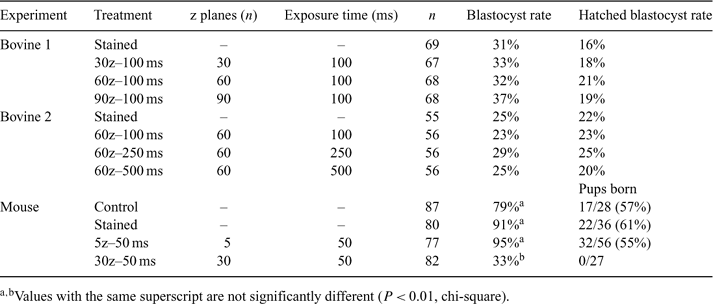184 EFFECT OF LIVE CONFOCAL FLUORESCENCE IMAGING ON EMBRYONIC DEVELOPMENT
P. Ross A and J. Cibelli ACellular Reprogramming Laboratory, Michigan State University, East Lansing, MI 48824, USA
Reproduction, Fertility and Development 18(2) 200-200 https://doi.org/10.1071/RDv18n2Ab184
Published: 14 December 2005
Abstract
The aim of this study was to examine the effects of fluorescent confocal imaging on embryo development. DNA damage, caspase activation, and reactive oxygen species (ROS) production were also measured. In vitro-generated bovine 8-cell embryos and in vivo-produced mouse 2-cell embryos were stained with Mitotracker Red and individually imaged using a spinning-disc confocal module (CARV) attached to a Nikon TE2000-U microscope. The sample was excited with a 120 W metal halide lamp (X-Cite 120) using a fluorescent filter set (Excitation: 575 nm; Emission: 640 nm). A variety of number and durations of exposures were tested. Continuous variables were analyzed by t-test, whereas categorical data were analyzed using the homogeneity chi square test. Bovine embryos showed no differences in blastocyst development (Day 7.5; Day 0 = IVF) or hatched blastocysts (Day 11) between groups of imaged and non-imaged embryos (Table 1). Despite numerous attempts, we were unable to find a level of exposure that disturbed embryo development, indicating that bovine embryos have a high degree of tolerance to the imaging system. After exposure, mouse embryos were cultured in vitro to the blastocyst stage and transferred into surrogate synchronized females. Embryos subjected to five exposures of 50 ms developed normally both in vitro and in vivo (Table 1). However, exposing the embryos 30 times significantly affected in vitro and in vivo development. Subsequently, we examined the effect of confocal imaging on DNA damage (Comet assay), ROS production (dichlorofluoresceindiacetate, DCF), and caspase 3 activation (PhiPhiLux®-G1D2). Bovine embryos were exposed to 60z–50 ms or 60z–500 ms, and mouse embryos to 5z–50 ms or 30z–50 ms after Mitotracker Red staining. We observed that caspase 3 was not activated when measured 1.5 h after imaging. Similarly, DNA damage was not different among embryos exposed at different levels of imaging. However, ROS production significantly increased in both bovine and mouse embryos after exposure to confocal imaging, and this increase correlated with fluorescence exposure level. We conclude that imaging bovine pre-implantation embryos with this system increased ROS production but did not disturb in vitro development (even at unnecessary high levels of exposure). In mouse embryos, in vitro development after imaging directly correlated with in vivo development. It remains to be determined whether the increase in ROS production and decreased developmental potential is due to the fluorescence exposure alone or the combined effect of fluorescence exposure and Mitotracker labeling.

|


